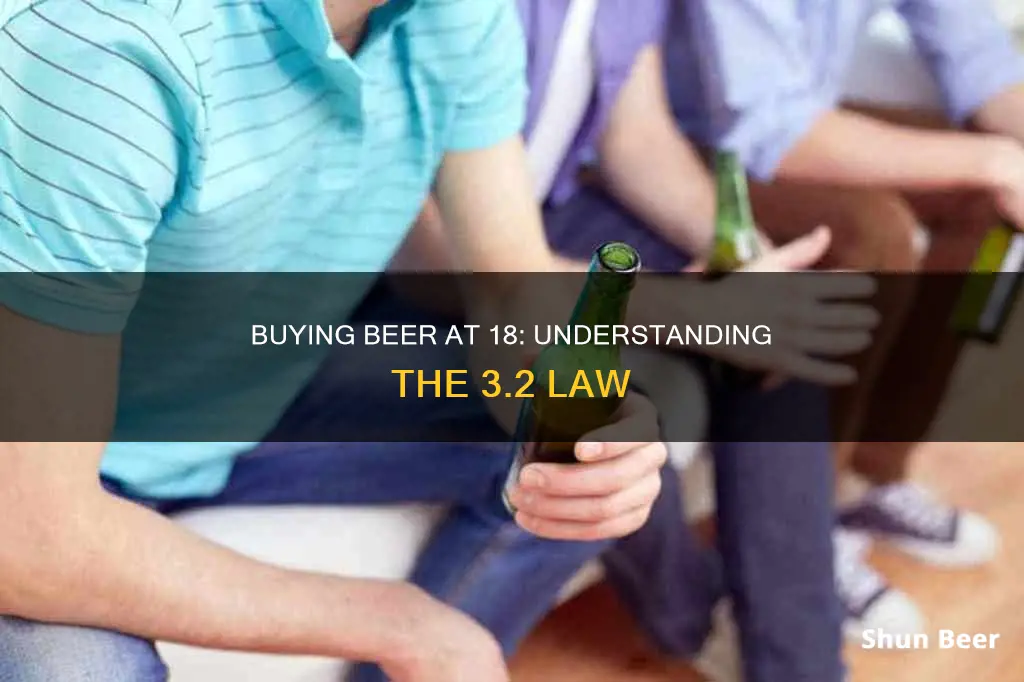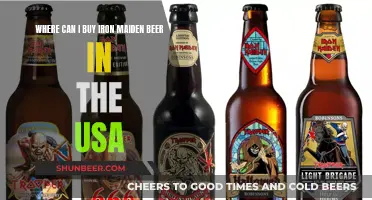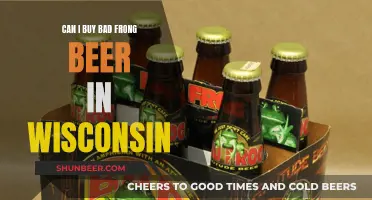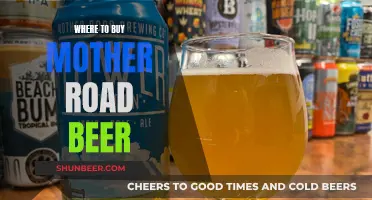
For many years, 18-year-olds in several U.S. states were legally allowed to purchase and consume beer with an alcohol content of 3.2%. This was a result of exceptions made by state lawmakers when Prohibition ended in the 1930s, allowing those under 21 to buy drinks with less than 3.2% alcohol by weight. However, by the 1980s, there was a growing backlash against teenage drinking, and states began to abolish these exceptions, with Colorado being one of the last to do so in 1987. Today, the minimum legal drinking age for any type of alcohol in the United States is 21.
| Characteristics | Values |
|---|---|
| Location | Colorado, Kansas, South Carolina, Washington D.C. |
| Time Period | 1930s-1980s |
| Beer Type | 3.2% alcohol by weight, 4% alcohol by volume |
| Age Restriction | 18 years or older |
| Availability | Special bars, grocery and convenience stores |
What You'll Learn

In the 1960s and 70s, 18-year-olds could buy 3.2 beer in most states
In the 1960s and 70s, many US states allowed 18-year-olds to purchase low-alcohol beer, with a maximum alcohol content of 3.2%. This was known as "3.2 beer" or "junior varsity" beer. States with this provision included Colorado, Kansas, South Carolina, and Washington, D.C.
The origin of 3.2 beer can be traced back to the end of Prohibition in the 1930s. In 1933, nine months before Prohibition was fully repealed, President Franklin D. Roosevelt signed the Beer and Wine Revenue Act, allowing beer with up to 3.2% alcohol by weight. This limit was arbitrary and not based on any specific scientific or health-related rationale.
During the social upheaval of the 1960s and early 1970s, there were calls for lowering the legal boundaries between childhood and adulthood. This was fuelled by the Vietnam War, as 18-year-olds were being drafted but did not have the right to vote, drink, or engage in other adult activities. As a result, there was a push for more rights for younger people, including the slogan, "Old enough to fight, old enough to drink."
Between 1970 and 1975, 29 states lowered the drinking age, and youth drinking became more prevalent. However, this trend was short-lived due to a spike in fatal accidents involving teenage drivers and a general backlash against the youth rights movement. By the mid-1980s, the country adopted a uniform minimum drinking age of 21, and states gradually scrapped the special rules allowing 18-year-olds to purchase 3.2 beer.
Today, the purchase and consumption of alcoholic beverages in the United States require individuals to be at least 21 years old, and the era of 3.2 beer has come to an end.
Spotted Cow Beer: Canada's Availability and Accessibility
You may want to see also

In 1987, Colorado stopped allowing 18-year-olds to buy 3.2 beer
In the United States, the legal drinking age is 21 years old. However, in the past, some states allowed teenagers to drink low-alcohol beer. Colorado was one of those states, with a long history of youth drinking.
In 1933, Colorado lawmakers decided that anyone aged 18 or older could buy and consume drinks with an alcohol content of under 3.2% ABW (alcohol by weight). Drinks with a higher alcohol content were reserved for those aged 21 and above. This exception came about as the country emerged from Prohibition, with the federal government setting somewhat arbitrary limits. Colorado was one of a few states to give 3.2 beer a "junior varsity" designation.
However, this exception came to an end in 1987. There were a few reasons for this change. Firstly, there was a growing backlash against youth drinking, with a spike in fatal accidents involving teenage drivers. This led to the formation of organisations like Mothers Against Drunk Driving, who pushed for a higher drinking age. Secondly, the federal government threatened to cut highway funding for non-compliant states. As a result, in the spring of 1987, Colorado lawmakers passed a bill to raise the drinking age to 21, bringing it into line with most other states.
This change had a significant impact on the culture of youth drinking in Colorado, which had been a part of the state's history for much of the 20th century. It also affected the alcohol industry, with breweries having to adapt to the new regulations. Today, the legal drinking age remains at 21, and lower-alcohol beers are finding a new audience with health-conscious consumers.
Buying Beer Abroad: Underage Americans Overseas
You may want to see also

3.2 beer is a hangover from Prohibition times
During Prohibition, there were efforts to treat alcohol as a public health concern and as a potentially dangerous product. The Cullen-Harrison Act, signed into law by President Franklin Roosevelt in 1933, legalized beer with an alcohol content of 3.2% by weight (approximately 4% alcohol by volume). This percentage was based on the work of scientists who studied the effects of alcohol and determined that certain low percentages were not intoxicating.
The 3.2 beer designation lasted beyond the end of Prohibition, which was repealed with the ratification of the Twenty-first Amendment on December 5, 1933. For a time, 3.2 beer was the only alcohol that could be sold in grocery and convenience stores in some states, and it was also the only type of alcohol that 18-year-olds could legally purchase and consume in certain states.
The laws surrounding 3.2 beer varied from state to state. For example, in Colorado, 18-year-olds could buy and drink 3.2 beer at special bars, while in other states, such as Kansas, Oklahoma, and Utah, the availability of normal-strength beer was severely restricted due to a lack of approved liquor stores.
The existence of 3.2 beer was due to the arbitrary nature of alcohol limits set during the Prohibition era, the influence of breweries and distributors, and the desire to control the flow of alcohol, especially to teenagers and young adults. Today, 3.2 beer laws have mostly been phased out, with Minnesota being the last state to sell this type of beer.
Colt 45 Beer: Where to Buy and Enjoy Responsibly
You may want to see also

3.2 beer is a compromise—an arbitrary number with no magic behind it
2% beer, also known as "3.2 beer" or "three-two beer", is a beer with a low alcohol content of 3.2% alcohol by weight (equivalent to about 4% alcohol by volume). This type of beer was particularly prominent in the United States after the repeal of Prohibition in 1933, as many states established a compromise that allowed the sale of beer, but with a limited alcohol content.
The 3.2% limit on alcohol content is indeed arbitrary and has no magic behind it. When Prohibition was repealed in 1933, there had to be a limit on the amount of alcohol allowed in beer, and so hearings were held to determine a standard that could gather the necessary votes. The compromise that was reached was 3.2% alcohol by weight, which is approximately 4% alcohol by volume. According to beer historian Maureen Ogle, author of "Ambitious Brew: The Story of American Beer",
> "The compromise ended up being 3.2 and it frankly, it's an arbitrary number. There's nothing magical about it."
Ogle also notes that the 3.2% standard took hold in many states as a middle course between allowing alcohol and not—a sort of "temperance light".
The history of 3.2% beer in the US is a fascinating one. In the early 20th century, as Prohibition was coming to an end, President Franklin D. Roosevelt signed the Beer and Wine Revenue Act, which set the alcohol limit for beer at 3.2%. This limit was a compromise, as Prohibition was still officially in place, and it was seen as a way to gradually reintroduce alcohol to the country.
Initially, this low-alcohol beer was sold primarily in grocery and convenience stores, and it became quite popular, especially among teenagers who could legally drink it in many states. However, by the 1980s, there was a growing backlash against teenage drinking, and states began to scrap the special rules for 3.2% beer. As of 2016 and 2019, only five states—Oklahoma, Colorado, Utah, Kansas, and Minnesota—still mandated the sale of these low-alcohol beers. Today, only Minnesota remains as the last state to sell 3.2% beer.
Dollar General Beer Buying Guide: What's Available?
You may want to see also

3.2 beer is still sold in Minnesota
2 beer, or beer with 3.2% alcohol by weight, is still sold in Minnesota. In fact, Minnesota is the last state in the US to sell this low-alcohol beer in grocery and convenience stores.
The history of 3.2 beer dates back to the end of Prohibition in the 1930s. As part of the transition, a law was passed allowing a maximum of 3.2% alcohol by weight brew. This was an arbitrary number, with nothing "magical" about it, according to beer historian Maureen Ogle. It was simply a compromise that could gather the necessary votes.
In the 1970s, many states allowed 18-year-olds to drink, including Minnesota, which led to increased sales of 3.2 beer. However, when the drinking age was raised to 21 nationally, the popularity of 3.2 beer began to wane.
Today, Minnesota is the only state left with laws mandating that only 3.2% beer can be sold in grocery and convenience stores. This has created a situation where liquor store owners are fighting to keep the law in place, while grocery and convenience stores are pushing for change.
State Senator Karin Housley has introduced a bill that would allow liquor licenses to grocery and convenience stores in Minnesota to sell full-strength beer, wine, and liquor. She argues that it is what consumers want and that it would promote free-market competition. However, liquor store owners worry that changing the law could hurt small, independent liquor stores and increase competition from large retailers.
The debate around 3.2 beer in Minnesota is complex and involves considerations of public health, consumer convenience, and the survival of small businesses. While it is unclear what the outcome will be, the fact remains that Minnesota is currently the last holdout for the sale of 3.2 beer.
Estrella Galicia Beer: Where to Buy and Enjoy It
You may want to see also
Frequently asked questions
Yes, for decades, 18-year-olds could buy 3.2 beer in Colorado. However, this changed in the 1980s.
Yes, until 2019, Kansas grocery and convenience stores could only sell beer with 3.2% alcohol. This was a rule since the 1930s.
Yes, in the 1960s and 1970s, 18-year-olds in most states could buy low-alcohol beer with a maximum alcohol content of 3.2%.
3.2 beer is a beer with 3.2% alcohol by weight, or 4% alcohol by volume. It was first introduced in 1933, nine months before Prohibition was repealed, as a compromise to limit the amount of alcohol in beer.
As of 2019, only Minnesota still sells 3.2 beer.







